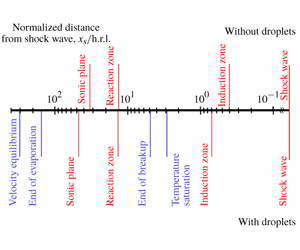Crossref Citations
This article has been cited by the following publications. This list is generated based on data provided by
Crossref.
Cuadra, Alberto
Huete, César
and
Vera, Marcos
2020.
Effect of equivalence ratio fluctuations on planar detonation discontinuities.
Journal of Fluid Mechanics,
Vol. 903,
Issue. ,
Egawa, Ryusuke
Fujimoto, Souya
Yamashita, Tsuyoshi
Sasaki, Daisuke
Isobe, Yoko
Shimomura, Yoichi
and
Takizawa, Hiroyuki
2020.
Exploiting the Potentials of the Second Generation SX-Aurora TSUBASA.
p.
39.
Huang, Zhiwei
and
Zhang, Huangwei
2020.
On the interactions between a propagating shock wave and evaporating water droplets.
Physics of Fluids,
Vol. 32,
Issue. 12,
Huang, Zhiwei
Zhao, Majie
Xu, Yong
Li, Guangze
and
Zhang, Huangwei
2021.
Eulerian-Lagrangian modelling of detonative combustion in two-phase gas-droplet mixtures with OpenFOAM: Validations and verifications.
Fuel,
Vol. 286,
Issue. ,
p.
119402.
Xu, Yong
Zhao, Majie
and
Zhang, Huangwei
2021.
Extinction of incident hydrogen/air detonation in fine water sprays.
Physics of Fluids,
Vol. 33,
Issue. 11,
Abbasov, E. M.
and
Agaeva, N. A.
2021.
Hydrodynamics of Instant Emptying of High-Pressure Liquid from Pipeline.
Journal of Engineering Thermophysics,
Vol. 30,
Issue. 3,
p.
515.
Zhao, Majie
and
Zhang, Huangwei
2021.
Rotating detonative combustion in partially pre-vaporized dilute n-heptane sprays: Droplet size and equivalence ratio effects.
Fuel,
Vol. 304,
Issue. ,
p.
121481.
Taileb, S.
Melguizo-Gavilanes, J.
and
Chinnayya, A.
2021.
The influence of the equation of state on the cellular structure of gaseous detonations.
Physics of Fluids,
Vol. 33,
Issue. 3,
Xu, Yong
and
Zhang, Huangwei
2022.
Interactions between a propagating detonation wave and circular water cloud in hydrogen/air mixture.
Combustion and Flame,
Vol. 245,
Issue. ,
p.
112369.
Tukmakov, D. A.
2022.
Numerical Simulation of Oscillations of Aerosol with a Low Dispersed Phase Concentration in a Closed Tube by the Continuum Mathematical Model.
Technical Physics,
Vol. 67,
Issue. 12,
p.
764.
Xu, Dequan
Luo, Shibin
Yang, Miao
Feng, Yanbin
and
Song, Jiawen
2022.
Inlet layout effects on the mixing performance with a novel mixing evaluation in a powder-fueled ramjet.
Fuel,
Vol. 327,
Issue. ,
p.
125145.
Huang, Xixuan
and
Lin, Zhiyong
2022.
Analysis of coupled-waves structure and propagation characteristics in hydrogen-assisted kerosene-air two-phase rotating detonation wave.
International Journal of Hydrogen Energy,
Vol. 47,
Issue. 7,
p.
4868.
Yang, Miao
Zhang, Jingyuan
Zhong, Shenghui
Li, Tian
Løvås, Terese
Fatehi, Hesammedin
and
Bai, Xue-Song
2022.
CFD modeling of biomass combustion and gasification in fluidized bed reactors using a distribution kernel method.
Combustion and Flame,
Vol. 236,
Issue. ,
p.
111744.
Guo, Hongbo
Xu, Yong
Li, Shuying
and
Zhang, Huangwei
2022.
On the evolutions of induction zone structure in wedge-stabilized oblique detonation with water mist flows.
Combustion and Flame,
Vol. 241,
Issue. ,
p.
112122.
Shi, Jingtai
Xu, Yong
Ren, Wanxing
and
Zhang, Huangwei
2022.
Critical condition and transient evolution of methane detonation extinction by fine water droplet curtains.
Fuel,
Vol. 315,
Issue. ,
p.
123133.
Zhang, Bo
Chen, Junyi
Shahsavari, Mohammad
Wen, Haocheng
Wang, Bing
and
Tian, Xiaotao
2022.
Effects of inert dispersed particles on the propagation characteristics of a H2/CO/air detonation wave.
Aerospace Science and Technology,
Vol. 126,
Issue. ,
p.
107660.
Xu, Yong
and
Zhang, Huangwei
2022.
Pulsating propagation and extinction of hydrogen detonations in ultrafine water sprays.
Combustion and Flame,
Vol. 241,
Issue. ,
p.
112086.
Xu, Yong
and
Zhang, Huangwei
2022.
Extinction and re-initiation of hydrogen detonation interacting with fine water spray column.
Jourdaine, Nicolas
Tsuboi, Nobuyuki
and
Hayashi, A. Koichi
2022.
Investigation of liquid n-heptane/air spray detonation with an Eulerian-Eulerian model.
Combustion and Flame,
Vol. 244,
Issue. ,
p.
112278.
Salauddin, S.
Morales, A. J.
Hytovick, R.
Burke, R.
Malik, V.
Patten, J.
Schroeder, S.
and
Ahmed, K. A.
2023.
Detonation and shock-induced breakup characteristics of RP-2 liquid droplets.
Shock Waves,
Vol. 33,
Issue. 3,
p.
191.



